by Federico Giannini (Instagram: @federicogiannini1), published on 05/12/2017
Categories: Works and artists
/ Disclaimer
It is the work that perhaps caused the most discussion at the 2017 Venice Biennale: Roberto Cuoghi's Imitation of Christ, for the Italian Pavilion.
"God is dead," came to mind as we walked through the imposing work that Roberto Cuoghi (Modena, 1973) presented at the 2017 edition of the Venice Biennale, which ended a few days ago. Dead and lying on a morgue table, disfigured, in an advanced state of decomposition, attacked by mold and bacteria until total physical disintegration, only to resurrect and again die and again disintegrate in a disturbing, dark and oppressive continuous cycle of birth and death. This, in a nutshell, was Roberto Cuoghi’sImitation of Christ.
More in detail: upon entering the first room of the Italian Pavilion, one found himself catapulted into the darkness of a forge, complete with blacksmiths and workers, continuously producing images of Christ, all in perishable material. The images, having emerged from their molds, were then spread out on tables that the visitor found inside a long nylon tunnel (somewhere between Merz’s igloos and Höller’s Y ) and left to the mercy of external agents (bacteria, spores, mold) that caused their natural dissolution: what remained was finally passed into an oven for drying and then hung on the back wall. The cycle therefore resumed, and for the duration of the Biennial Cuoghi’s alienating factory continued to produce these slender, wispy, never identical bodies destined for ruin. The basic idea was inspired, as the title clearly suggests, by the fifteenth-century treatise De Imitatione Christi whose reading was meant to suggest to the faithful how to live a good Christian life following the example of Jesus Christ. In the twenty-third chapter, we read these sentences, “Soon death will be from you: consider therefore your state. Today you are a man, but tomorrow you will disappear. And when thou art taken from the eyes, thou shalt also disappear from the mind.” This is probably the premise from which Roberto Cuoghi’s work started, only to lose all point of contact with the ancient text.
A work that did not fail to call to the visitor’s mind wide passages of art history, with an effect obtained in a more or less conscious way: a sort of Nachleben, of Warburgian survival evoked by gestures, symbols, postures, glances. For Cuoghi’s decomposed Christs hold traces of many works of the past, beginning at the beginning of the itinerary, with those empty icons that introduced the visitor to the gloomy Venetian workshop, similar to negative images of Beato Angelico’s Christ of Livorno: a work just as powerful (the Tuscan artist’s most dramatic), just as serious, just as suffered, but aimed at strengthening the faith of the viewer. The same goal that, throughout art history, other equally strong images have sought to achieve, which can be considered almost antecedents to Cuoghi’s bodies of Christ abandoned on morgue tables. More specifically, Cuoghi’s bodies are certainly reminiscent of Hans Holbein’s Dead Christ, an unprecedented work in the history of Western art that, although conceptually distant, shares with the Modenese artist’s installation the desire to show, without filters of any kind, the corruptibility of Christ, but even more reminiscent of certain terracotta mourners from the Emilian area (for example, that of Alfonso Lombardi in St. Peter’s Cathedral in Bologna, more than the celebrated one by Niccolò dell’Arca in Santa Maria della Vita) whose creative process was not so dissimilar to that staged by Cuoghi, and which fit into the groove of that anticlassical and naturalist tradition of Emilian art to which Arcangeli devoted much of his studies and which seems to be revived in Cuoghi’s art, similarly anticlassical, crude, and realistic to the point of disturbing the observer. With the difference that those works were meant to stay: Cuoghi’s, on the other hand, are destined for destruction. And in all this, unless one wants to linger on the rituality of the process or on the aura of spirituality surrounding Cuoghi’sImitation of Christ, there would seem to be very little magic, in spite of the title Il mondo magico (The Magic World ) that curator Cecilia Alemani had devised for the Italian Pavilion, referring to Ernesto De Martino’s book of the same name. Of course, one can amuse oneself with the (trite) stereotype of theshaman artist who stages a collective ritual in which we are all participants, or again with the myth of theartist-alchemist who decides on life and death in his workshop, and so on. Cuoghi’s work, however, is more refined.
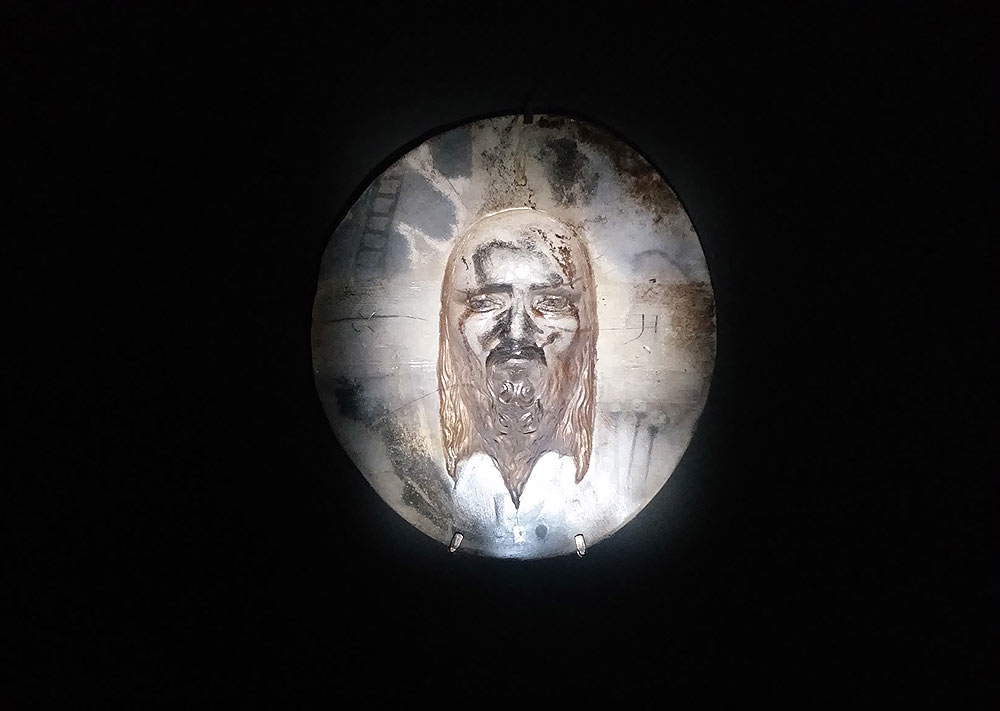 |
| Roberto Cuoghi, Imitation of Christ (2017). Beginning of the path with negative icons. Ph. Credit Finestre Sull’Arte. |
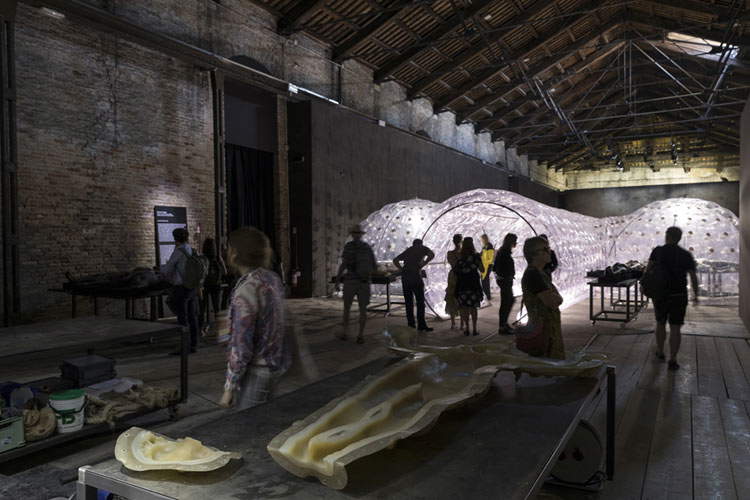 |
| Roberto Cuoghi, Imitation of Christ (2017). The work seen from the beginning of the route. Ph. Credit Roberto Marossi. Courtesy Roberto Cuoghi |
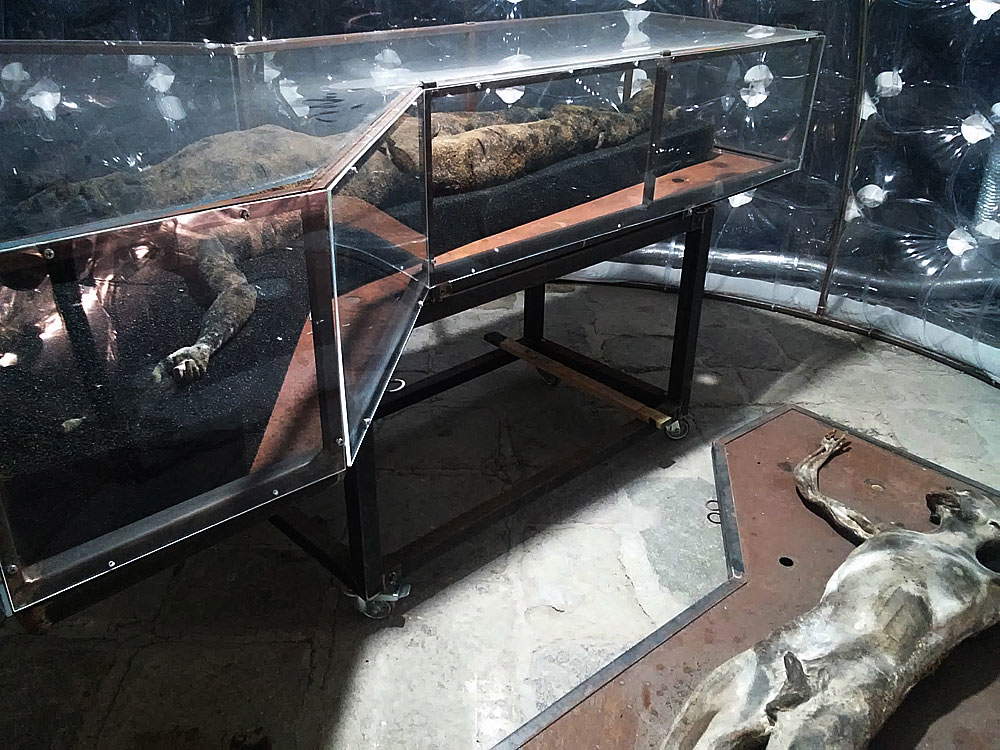 |
| Roberto Cuoghi, Imitation of Christ (2017). Inside the tunnel. Ph. Credit Finestre Sull’Arte. |
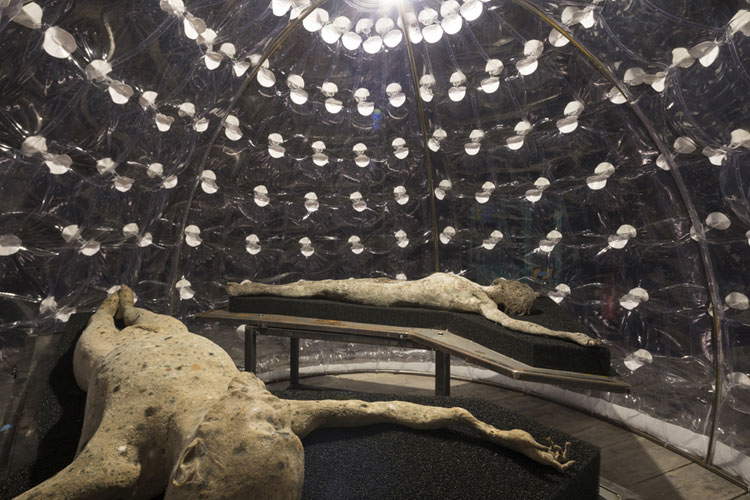 |
| Roberto Cuoghi, Imitation of Christ (2017). Decaying bodies in igloos. Ph. Credit Roberto Marossi. Courtesy Roberto Cuoghi. |
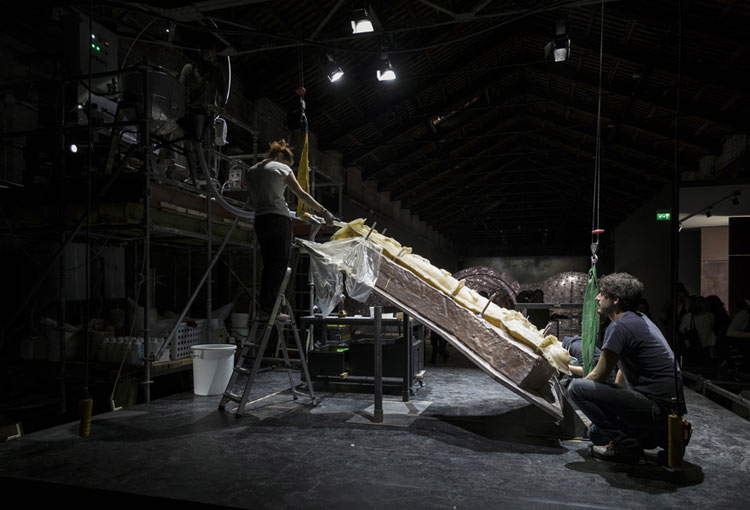 |
| Roberto Cuoghi, Imitation of Christ (2017). Workers at work. Ph. Credit Roberto Marossi. Courtesy Roberto Cuoghi. |
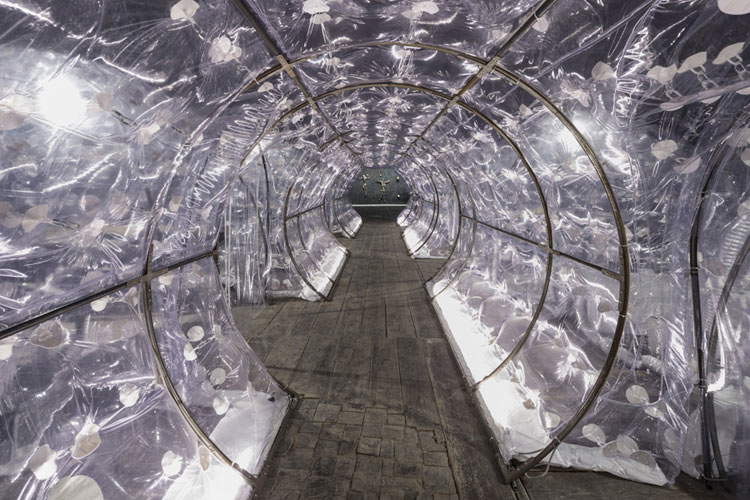 |
| Roberto Cuoghi, Imitation of Christ (2017). Walking through the tunnel. Ph. Credit Roberto Marossi. Courtesy Roberto Cuoghi. |
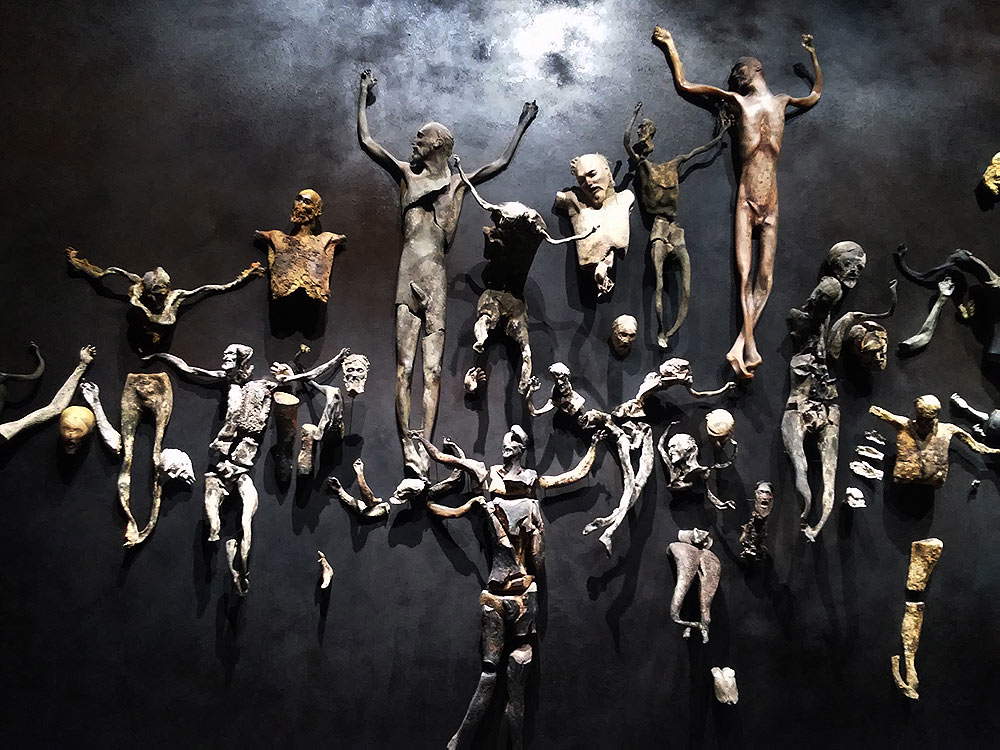 |
| Roberto Cuoghi, Imitation of Christ (2017). The end result: the Christians hanging on the back wall. Ph. Credit Finestre Sull’Arte. |
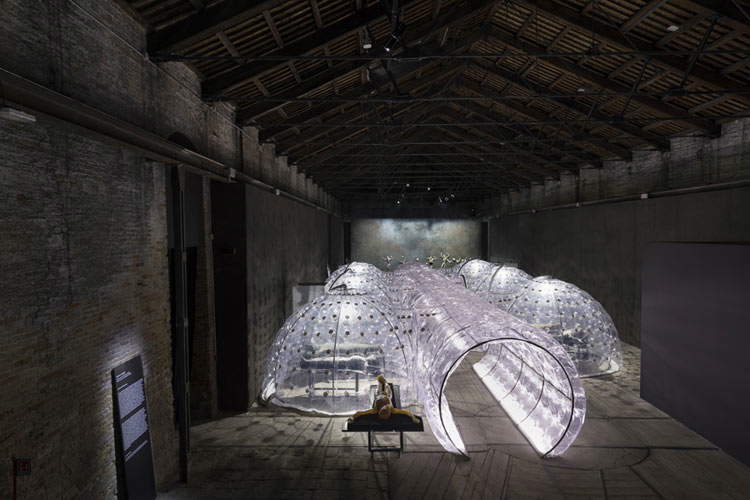 |
| Roberto Cuoghi, Imitation of Christ (2017). The work seen from above. Ph. Credit Roberto Marossi. Courtesy Roberto Cuoghi |
Cecilia Alemani rightly points out that the magical is actually a starting point for a new reading of reality: and it is in this"reconstruction of reality" that the meaning of the work probably needs to be found. The path conceived for the Italian Pavilion seemed almost to mix mysticism and skepticism, the sacredness of the image of the Lord and the mundanity of a decadent circus set-up, asceticism and concreteness taken to its most brutal extremes (in a manner, moreover, entirely consistent with the artistic path of Roberto Cuoghi, one of the most provocative and unsettling artists on the contemporary scene): at the end of the alienating journey that took the visitor inside the places where the destruction of the body of Christ physically took place, one was confronted with what was left of it. And what remained was a series oftorn icons, screaming crucifixes that again harkened back to art history: from certain distressing medieval crucifixions (think of the horrifying ones by the Master of St. Anastasia) to Wildt’s dramatic masks, or the most violent crucifix of the 20th century, the one Ludwig Gies executed for Lübeck Cathedral, shrunken, twisted, and ravaged like Cuoghi’s hanging Christs, and so shocking that the Nazi madness detached it from its seat and, in a famous episode of modern iconoclasm, tore it to pieces by throwing its head into the Trave, the river that washes Lübeck. Torn icons that induced the visitor to reflect on the inevitability of time (and in his reflection on time, a theme that has always fascinated artists of all ages, Cuoghi places himself outside of time), on faith, on the sense ofidentity, on the persistence and regeneration of symbols, on the contradictions of religion, but also, if we wish, on those of our society.
The most interesting fact about Cuoghi’sImitation of Christ was that it was a work that provided no answers: certainties were crushed under the weight of the fake relics that populated the Italian Pavilion and, unlike the faithful who, reading the De Imitatione Christi, should have undergone a sort of inner transformation that would have led him toward a life in the sign of the steadfastness of faith, the observer of Roberto Cuoghi’s work could not but leave the Italian Pavilion assailed by uncertainty, if only simply that of understanding what the artist had really wanted to communicate to him. And, in this regard, there is also nothing to prevent us from thinking that the work could also take on the appearance of a vacuous and repetitive liturgy aimed at mortifying the role of an artist destined to the same process to which the bodies of Christ in ruins, his alter egos and, like him, mute icons, are subjected. What is certain is that, if what Braque said is true, that art must disturb, then Cuoghi has succeeded very well in that intent.
Warning: the translation into English of the original Italian article was created using automatic tools.
We undertake to review all articles, but we do not guarantee the total absence of inaccuracies in the translation due to the program. You can
find the original by clicking on the ITA button. If you find any mistake,please contact us.




































